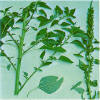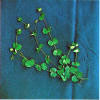What is a Weed?
Our world is green, with many kinds of plants. All plants are in some way useful and beneficial. But some plants are undesirable in situations created by man to serve his particular needs. This page includes picture to help you identify weeds.
These plants are called "weeds," and are most simply defined as "plants out of place." This definition may be expanded to include any plant that:
- Presents difficulty in cultivating desirable plants.
- Has a potential for decreasing the value of plant and animal products.
- Causes losses through increased cultivation or harvesting costs.
- Presents a hazard of poisoning man or animals.
- Interferes with the enjoyment of outdoor recreation.
- destroys the aesthetic value of turf and other ornamental plantings.
Weeds are known by everyone, but are not necessarily recognized. Effective selective weed control efforts depend upon the ability to recognize (identify) plants, thereby permitting an intelligent choice of cultural practices and herbicide use.
This webpage should aid in recognizing 120 of the more common weeds in the Southern United States (Alabama, Arkansas, Florida, Georgia, Kentucky, Louisiana, Mississippi, North Carolina, Oklahoma, South Carolina, Tennessee, Texas and Virginia). Please realize that there are more than 300 common names for these same weeds.
Priorities were assigned for use on the basis of most common occurrence and/or difficulty of control. We have attempted also to represent all the southern states with weeds peculiar to the widely varying environments. Nevertheless, there are at least 180 weeds of lesser importance which are not shown, and which present problems over large or local areas.
Common names of weeds conform to the Weed Science Society of America Terminology Committee report.
Botanical names conform first to the WSSA Terminology report, or alternatively to Smalls's "Manual of Southeastern Flora," or to Gray's "Manual of Botany."
Learn More About Weeds

Carpetweed
Mollugo verticillata
Summer annual. Stems green, smooth. Branches along ground in all directions from swollen nodes, forming flat mats. Smooth, tongue like leaves in spread clusters of five to six at each joint. Flowers small, white Seed is orange-red. Found in cultivated soils.

Redroot Pigweed
Amaranthus retroflexus
Summer annual. Stems erect, to six feet tall, rough textured, freely branching. Pull green leaves, long petioles. Small, green flowers in dense spikes in upper leaf axils and stem ends, with three spiny bracts around each flower. Shiny black, tiny seed. Found in cultivated fields, barnyards, fencerows and waste areas.
Smooth pigweed (A. hybridus) is similar but petioles shorter, plant texture not rough, with fewer, less dense flower spikes

Spiny Amaranth
Amaranthus spinosus
Summer Annual. Reddish, nearly smooth, slightly branched in lower proportion. Plant is one to three feet tall. Leaves alternate, dark green. Spines 1/4 to 1/2 inch long, in leaf axils. Small, spiny flowers in dense, finger-like spikes at ends of stems and branches. Shiny black seed. Found in Livestock feeding and holding areas, cultivated fields.

poison-ivy
Rhus radicans
Perennial woody vine or shrub, often climbing by short rootlets on trees or fences. Smooth stems, light brown to grayish. Alternate leaves with three large, broad, shi,ny leaflets with either smooth or irregular-toothed edges. Smooth, almost round, greenish-white berries about 1/4 inch diameter. Found in open woods, fencerows, old fields and on ditch banks.

hemp dogbane
Apocynum cannabinum
Perennial. Stems erect, one to three feet tall from woody, horizontal rootstocks, with milky sap. Leaves smooth, elliptical, narrow, erect. Flowers small, with five greenish-white petals. Seed pod long and slender, curved. Seed with soft, silky hairs on one end. Found in old fields and wasteland.

honeyvine milkweed
Ampelamus albidus
Perennial. Smooth, twining vine, without milky juice. Opposite leaves smooth, broad, heart-shaped, pointed, with long petioles. Small, whitish flowers in clusters on stalks from leaf axils. Seed pod brownish-green, smooth and pointed. Seed brown, oval, flattened, with silky white hairs. Found in rich, moist, cultivated fields and fence rows.

butterfly milkweed
Asclepias tuberosa
Perennial. Stems usually one to four, clustered from rootstock, one to two feet long. Stems without noticeably milky sap. Leaves broadly oval, rough-hairy, clasping stem. Flowers in clusters or racemes, variable color from light yellow to orange to red. Seed pod a follicle, egg-shaped seed with silky white hairs. Found on dry, open soils.

trumpetcreeper
Campsis radicans
Perennial woody vine. Spreads by seed and roots. Stems smooth, 20 to 40 feet long. Leaves opposite,6tbl$inches long, compound, with 7 to 11 leaflets. Flowers fu1}nel- or trumpet-shaped, large, color orange to scarlet, in short- stemmed clusters. Seed pod four to six inches long, round but flattened on two sides, slightly curved. Found in fence rows and fields.

japanese honeysuckle
Lonicera japonica
Perennial twining or trailing woody vine. Leaves oval, smooth margins, short petioles. Young stems green to red, gray and brittle with age. Flowers white or tinged with purple, turning light yellow. Very fragrant. Berries black. Aggressive weed found in fencerows, forestland and old fields.

corn cockle
Agrostemma githago
Winter annual. Stems erect, slender, rough, hairy, swollen at joints Leaves opposite, joined at base. Flowers large, reddish-purple to purple. Seed pod ribbed, bladder- or urn-like, seed lack and rough. Seed poisonous. Found in grain crops.

heartleaf drymary
Drymaria cordata
Annual. Stems prostrate, succulent, spreading. Leaves round to kidney-shaped, opposite, bright green. Flowers inconspicuous, With oval seed pod. Found in gardens, roadsides, ditches in warmest regions of Southeast.

mouseear chickweed
Cerastium vuIgatum
Perennial. Hairy, slender, spreading to erect stems. Leaves small, very hairy, opposite, attached directly to stem. Five small, white flower petals notched at tips. Seed pods very small with many tiny, brown seed. Found in lawns, pastures, abandoned fields.
Helpful Tips

Top Dressing your Lawn - Dillo Dirt
Top dressing your lawn
Tips on top dressing your lawn...

Winter Stress
How can I help my trees survive winter?
Will your trees survive the snow, ice, winter, cold, and winter sun? There are....

 config
config view
view logs
logs 9472.0 KB
9472.0 KB 105 ms
105 ms



